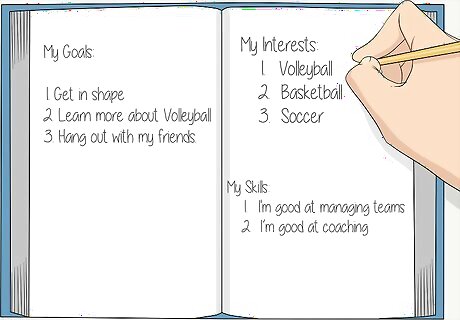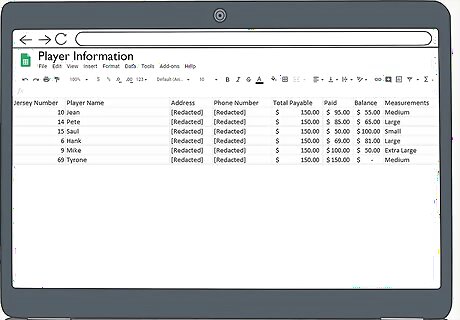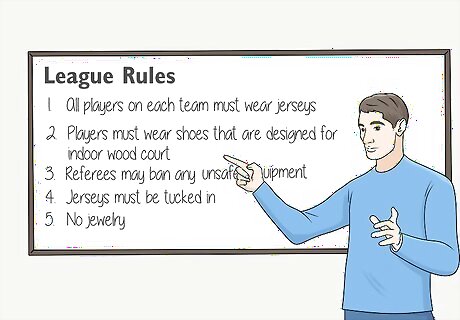
views
Choosing a Sport and League

Write down a list of your goals, interests, and skills. There are plenty of different reasons to start a sports team. You might, for example, want to be a teacher and positive role model for kids, or you might want to play a particular sport with other adults. To narrow down your own reasons, take some time to consider the following: Your goals. Are you hoping to get in shape? Learn more about a sport? Give local kids a recreation option? Hang out with your buddies? Your interests. Are you a fan of sports in general, or of a particular sport? Would you like to play, coach, do both, or do neither? How high on your list of priorities would your sports team be? Your skills. Do you have playing experience in particular sports? Are you a good teacher, leader, motivator, and/or communicator? Or are you better at organizing and doing behind-the-scenes work?

Pick a sport that suits your preferences as well as practical realities. You might, for instance, wish to start an adult rec-league baseball team, yet find that there isn’t a league or much player interest in your area. You may, however, be able to start an adult rec-league basketball team, or form a youth-league baseball team. Think about which sports are most popular in your area and which sports you enjoy and know the most about. It will be easier to start a team in a sport that’s in both of these categories.

Identify local sports leagues that meet your criteria. If you’ve decided you want to start a youth-league baseball team, for example, start researching existing leagues in your area. There may be only one league, but if there are several, take into account things like age range, skill level, locations, and costs. If your local government has a recreation authority, contact it to see if they operate or support any sports leagues. Or, see if any nearby companies operate or support teams or leagues. Be willing to expand your horizons a bit as well. The only youth baseball league in the area might involve more travel than you’re able to commit to, but maybe there is a youth softball league that requires far less travel. It’s possible to start up your own league, of course, but keep in mind that this will involve significantly more time, effort, and money than starting a team.

Tally up the costs for starting a team. The more players needed and the more equipment required, the more expensive a sport tends to be. A basketball team, for instance, is usually less expensive to operate than an ice hockey team. Work with the league you’ve elected to join to come up with a solid estimate of the startup and operational costs. Factor in costs for things like uniforms and equipment, practice and playing field rentals and/or maintenance, team travel, league registration and entry fees, game officials (referees, umpires, etc.), injury insurance, and training and/or safety clearances for coaches. The league may be able to help you connect with local businesses or organizations for sponsorships, or it may be up to you to seek out sponsorships to help defray your team's operating costs.
Building a Team

Create a catchy team name, logo, and uniform. You might think these things can wait until you’ve actually assembled a team. However, “branding” your team right away makes it easier to draw in players. Take into account your prospective player pool and think about what will appeal to them. Use an online random sports team name generator for a unique name, or grab a dictionary and a thesaurus for some creative inspiration. Rely on your own artistic skills to create a simple team logo, or search online for logo creation sites—you may be able to get a custom design for as little as $50 USD. Choose a team color scheme and uniform style that you think will appeal to your target pool of players. For example, you might choose a name and color pattern that is reminiscent of a popular college or professional sports team in your area. If, for instance, the local college team is the Bears, you might call your youth team the Cubs.

Spread the word about your team online and in person. Use all methods at your disposal to let potential players (and parents, if it’s a youth team) know about your new team. Utilize your team name, logo, and color scheme as you spread the word. Use social media to inform potential players and/or parents. Use your personal accounts, but also consider creating “official” team accounts. You may even want to create a team website. Don’t ignore low-tech methods like posting flyers in spots where potential players will see them. For example, you might post flyers for a youth team at the local library and ice cream shop.

Collect required info and payments from your players. As you start to sign up interested players, make sure you have good systems in place for collecting key things like contact information and payments (such as registration fees). Set up a spreadsheet, for instance, to keep track of things such as: Names, addresses, phone numbers, and email addresses of interested players. For youth teams, you'll need information from parents or guardians as well. Completion of registration forms and collection of registration fees. Signups for insurance or insurance waivers (if required by your league). Relevant measurements for uniforms and equipment.

Schedule practices that suit your team’s needs. As your team roster fills out with players who have signed up, ask for any preferences or restrictions regarding practice times and locations. Accommodate the players as best you can, but also make sure that the practice schedule works well for you. For a youth team, for example, don't schedule late evening or night practices. You may also have to arrange for carpools with parents. Make sure you’re also aware of any league rules regarding practice times or locations.
Managing Your Team

Take a positive leadership role that benefits your players. As the founder, it’s up to you to set the tone for the team. It doesn’t matter if you’re the on-field coach or if you delegate that role to someone else—make sure that the team reflects the encouraging and supportive leadership style that you ought to provide. If you’re coaching a baseball team for younger kids, for example, then your leadership focus may be on teaching essential baseball skills and promoting teamwork in a fun atmosphere.

Learn and adhere to league rules and requirements. It’s your ultimate responsibility to make sure that your team knows and follows the rules. No matter if you have a team of kids or adults, emphasize the importance of fairness and good sportsmanship. Make it clear that rule-breaking won’t be tolerated. Set up a clearly-defined procedure of progressive discipline for anyone caught breaking the rules. Go over your team and league rules and spell out the consequences. For instance, it may be a league rule that arguing with an umpire, referee, or game official results in an automatic ejection and 1-game suspension.

Lead fundraising activities to support your team. Unless you’ve fully opened your wallet to bankroll the team, you’ll likely have to rely at least in part on fundraising efforts. Don’t treat fundraising like a chore that the players have to deal with. Instead, play a leading role yourself and make it part of your team-building efforts. If your team is fundraising by selling coupon books for the local sandwich shop, get out there and sell along with the players! Don’t emphasize which players have raised more and which have raised less. Instead, focus on the amount raised by the entire team and encourage them to support each other in raising more.

Remember to have fun! Starting and running a sports team is a lot of work, but it should be enjoyable work. Don’t let the inevitable hassles and unexpected problems make you forget why you got involved in the first place. It can be even harder to have fun if your team loses a lot, but look for moments of fun and joy in the midst of losing. Also make sure to praise players when they give good efforts and display good teamwork and sportsmanship.
















Comments
0 comment